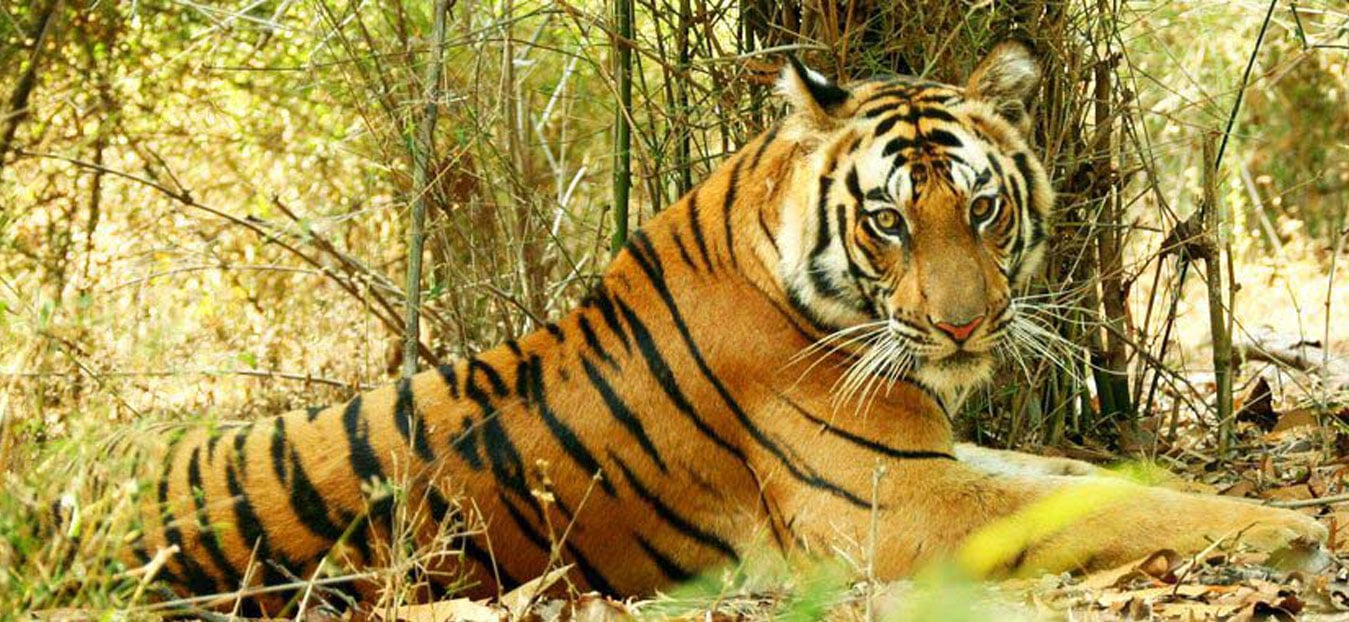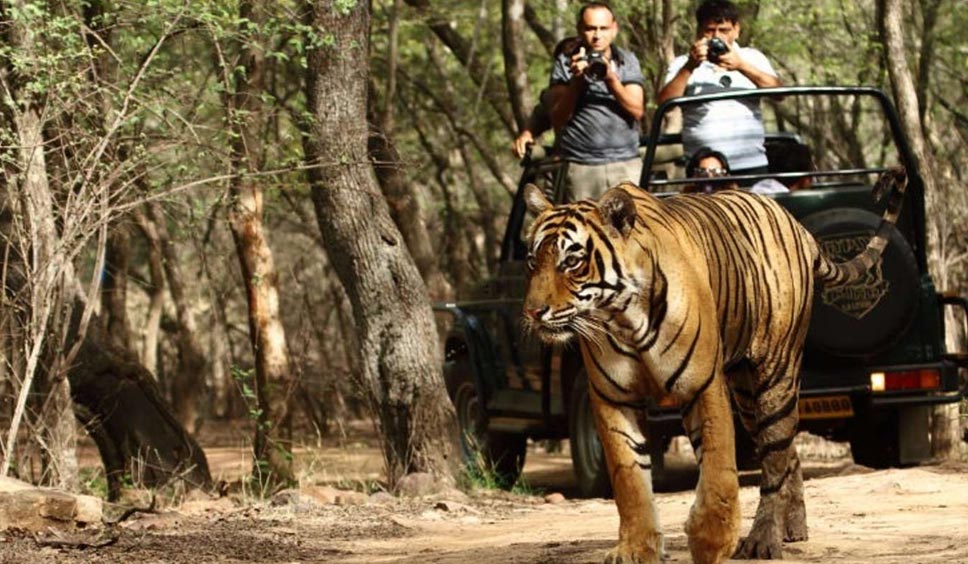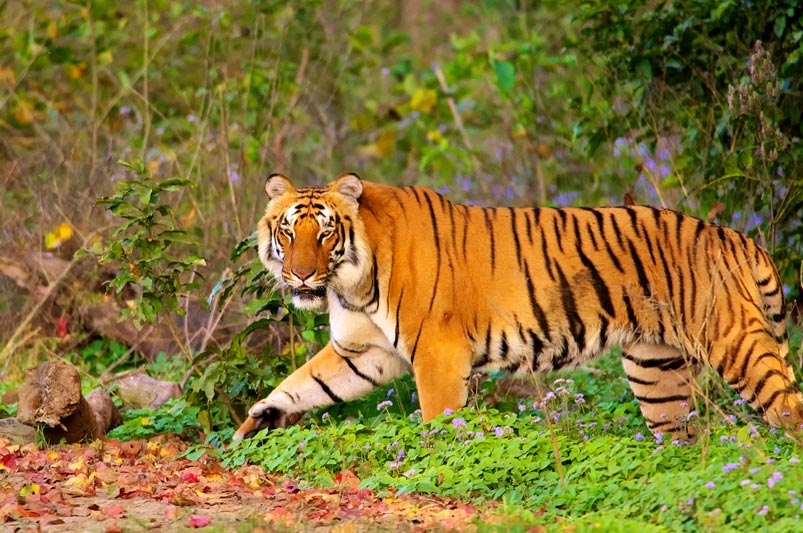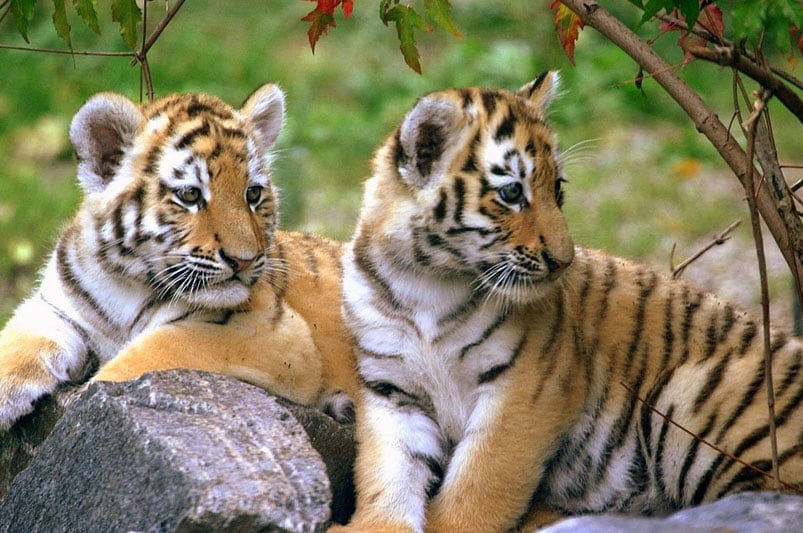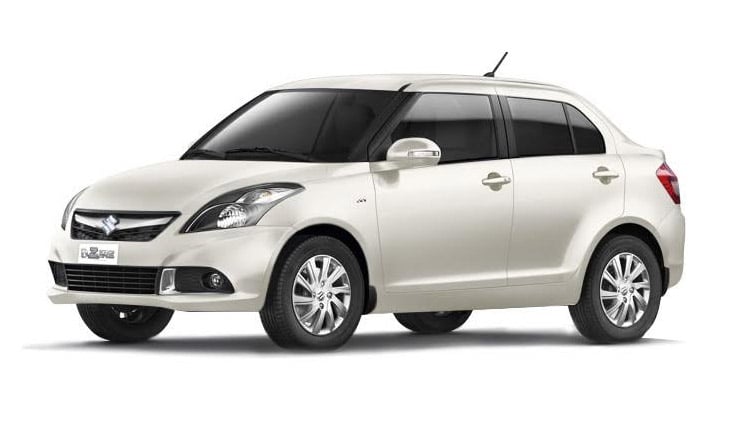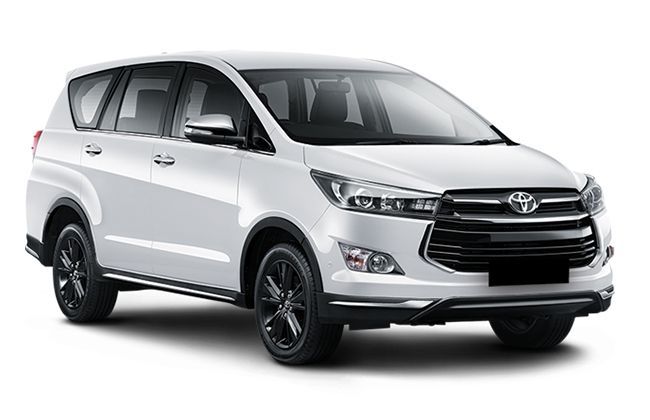14 days wildlife tour
Delhi - Jaipur - Ranthambore - Agra - Jhansi -Khajuraho - Bandhavgarh - Kanha - Nagpur - Delhi
14 Days Best Wildlife Package of India is an interesting and spectacular Indian Tour – combining history, culture with wildlife. The important touristic cities of India you will be visiting are Delhi, Jaipur, Agra, Khajuraho & Mumbai. The important wildlife sanctuaries you are visiting are Ranthambore, Bandhavgarh & Kanha. This is one of India’s finest packages for wildlife lovers.
Accomodation with breakfast, All transfers & city tours with air-conditioned vehicles.
 On your arrival in Delhi, you will be met by our representative and transferred to the hotel. Delhi was the capital of the Pandavas during the Mahabharata. This magnificent city has been inhabited from the 6th century BC and has been a capital of many kingdoms. It has been destroyed and rebuilt many times and is called the "city of cities". Delhi's culture has been influenced by its different rulers and the city is full of beautiful monuments. The Mughal rulers influenced the food habits of the residents and Mughlai cuisine originated here. Due to the proximity of different states, all festivals are celebrated here. Old Delhi is a maze of small lanes lined and old buildings and New Delhi has large road with huge buildings. Delhi is the capital of India and is the hub for politics. Your Golden Triangle & wildlife tour starts from today.
On your arrival in Delhi, you will be met by our representative and transferred to the hotel. Delhi was the capital of the Pandavas during the Mahabharata. This magnificent city has been inhabited from the 6th century BC and has been a capital of many kingdoms. It has been destroyed and rebuilt many times and is called the "city of cities". Delhi's culture has been influenced by its different rulers and the city is full of beautiful monuments. The Mughal rulers influenced the food habits of the residents and Mughlai cuisine originated here. Due to the proximity of different states, all festivals are celebrated here. Old Delhi is a maze of small lanes lined and old buildings and New Delhi has large road with huge buildings. Delhi is the capital of India and is the hub for politics. Your Golden Triangle & wildlife tour starts from today.
 Your morning tour starts with Old Delhi, built by the Mughal emperor Shah Jahan in 1639 AD. You will visit the Raj Ghat where father of our nation Mahatma Gandhi was cremated. You will be visiting the museum that was built to commemorate him. You will be driven past the iconic Red Fort and Chandni Chowk, a very popular and a busy market in Old Delhi to the next stop - Jama Masjid, one of the iconic, historic and largest mosques in India - built by Shah Jahan. A rickshaw ride in Chandni Chowk could be quite interesting as this part of the city is quite crowded as it is full of shops. These numerous shops sell delicious mouth-watering food, clothes, jewels, household, etc. and are virtually a shopper's paradise.
Your morning tour starts with Old Delhi, built by the Mughal emperor Shah Jahan in 1639 AD. You will visit the Raj Ghat where father of our nation Mahatma Gandhi was cremated. You will be visiting the museum that was built to commemorate him. You will be driven past the iconic Red Fort and Chandni Chowk, a very popular and a busy market in Old Delhi to the next stop - Jama Masjid, one of the iconic, historic and largest mosques in India - built by Shah Jahan. A rickshaw ride in Chandni Chowk could be quite interesting as this part of the city is quite crowded as it is full of shops. These numerous shops sell delicious mouth-watering food, clothes, jewels, household, etc. and are virtually a shopper's paradise.
 In the afternoon, you will visit Qutub Minar, touted as India's largest Minaret. Qutub Minar, a UNESCO World Heritage Site, was built in 1192 by Turk ruler Qutub-Ud-Din Aibak. You will then move forward to Humayun's tomb, yet another UNESCO world heritage site. Your next stop is India Gate, built in memory of the Unknown Soldier. You will be driven past the Parliament House, President's House and other Government Secretarial Buildings, to your final destination which will be Lakshminarayan Temple, a temple dedicated to Lakshmi and Lord Narayana. Overnight is in Delhi.
In the afternoon, you will visit Qutub Minar, touted as India's largest Minaret. Qutub Minar, a UNESCO World Heritage Site, was built in 1192 by Turk ruler Qutub-Ud-Din Aibak. You will then move forward to Humayun's tomb, yet another UNESCO world heritage site. Your next stop is India Gate, built in memory of the Unknown Soldier. You will be driven past the Parliament House, President's House and other Government Secretarial Buildings, to your final destination which will be Lakshminarayan Temple, a temple dedicated to Lakshmi and Lord Narayana. Overnight is in Delhi.
Early in the morning, you will be driven to Jaipur. Jaipur, also known as the pink city is the capital of Rajasthan. Many captivating palaces are present here having breathtaking design and architecture. In the 18th century Prince of Wales had visited Jaipur and the entire city was painted in pink color and due to these pink buildings the city is known as the pink city. Origin of Jaipur is 260 years back. It was built by Maharaja Jai Singh and Jaipur got its name from this king. The rest of the day could be spent visiting the Jaipur bazaars or walking down the crowded colorful streets. The transport is at your disposal for any additional visits of monuments or restaurants or places of interest which are with-in the city limits. Overnight in Jaipur.
Or you could opt for an optional tour of Galtaji, Sanganer, etc. Galtaji with several temples and sacred water tanks is an important site for Hindus. The Temple of Galtaji built in pink stone has pavilions, carved pillars and painted walls. The other important temples in Galtaji are Balaji temple, Sun Temple and Ramgopalji Temple. A large number of monkeys are always present in the Ramgopalji temple complex due to which it is known as the Monkey temple. Out of the seven sacred water tanks known as kunds, the Galta Kund is the most sacred. Every year, on the auspicious day of Makar Sankranti, thousands of devotees bathe in these kunds.
Sanganer is very famous for textile printing and also for its Jain temples. In the Sanganer prints, the designs in colors are printed on a white background. Sanganer draws a large number of devotees due to the Shri Digamber Jain temple made of red stone. The deity here is Lord Adinath - the first Tirthankara. Like most of the other join temples, this temple also has the finest carvings and was built in phases during different times. The last part was constructed in the 10th century AD as per an inscription on one of the Toranas. The temple has seven underground floors kept closed due to old beliefs. Visitors are not allowed to enter the underground floors and only an ascetic Digamber saint can enter these floors. Overnight is in Jaipur.
Today you will enjoy a full day tour of the Pink City. Your journey starts from Amer fort also known as Amer Palace, the earlier capital of Jaipur. This magnificent fort was constructed in red sand-stone and marble by Raja Man Singh and is divided into four sections each with a courtyard. The main entrance gate is Surajpol having a fascinating architecture. Near the Ganesh Gate, there is a temple dedicated to the Goddess Sila Devi. The Diwan-e-Aam - hall of public audience, Diwan-e-Khas - hall of private audience, Sheesh Mahal - palace of mirrors and Sukh Niwas are quite beautiful. At the Sukh Niwas, a pleasant climate is created by winds that blow over a water cascade. You could ascend the fort by walking up the steps or on an elephant's back or in jeep.
In Jaipur you will be taken to Maharaja City Palace, a royal palace with seven storeys as well as Jantar Mantar, the observatory. This wonderful observatory attracts mathematicians as well as astronomers from the whole world. City palace is perfect blend of all three excellent styles (Mughal, Rajput and European). Another palace, Hawa Mahal is popular all over world for its magnificent architecture. You will be taken through Pink Rose Garden as well business centers of Jaipur. A tour of Jaipur is not complete without shopping. Jaipur is famous for clothes, carpets, precious and semi-precious stones and jewelry and various handicrafts made of wood, metal, etc. and also for silk paintings and miniatures. The transport is at your disposal with-in the city limits. Overnight in Jaipur.
 This morning you will be transferred by road to Ranthambore National Park. Ranthambore National Park is a large national park and is famous for its tigers and is named after the Ranthambore fort, which is in the national park. The Ranthambore sanctuary has a large tiger population which makes a tiger sighting easier than most of the other parks. The major animals in Ranthambore National Park are leopard, nilgai, wild boar, sambar, and spotted deer, etc. The park has many lakes and you could easily see a lot of crocodiles and monitor lizards basking in the sun. This evening you will have your first Indian Wildlife tour in one of the best National Parks of India. Overnight is in Ranthambore National Park.
This morning you will be transferred by road to Ranthambore National Park. Ranthambore National Park is a large national park and is famous for its tigers and is named after the Ranthambore fort, which is in the national park. The Ranthambore sanctuary has a large tiger population which makes a tiger sighting easier than most of the other parks. The major animals in Ranthambore National Park are leopard, nilgai, wild boar, sambar, and spotted deer, etc. The park has many lakes and you could easily see a lot of crocodiles and monitor lizards basking in the sun. This evening you will have your first Indian Wildlife tour in one of the best National Parks of India. Overnight is in Ranthambore National Park.
Your morning and evening will be spent viewing the wildlife in the sanctuary. Ranthambore Game Sanctuary has a large variety of trees, plants, birds and reptiles. It has more than 270 species of birds and 500 species of plants. Padam Talao is the largest lake in the park and India's second largest banyan tree is near the lake. Due to environmental issues, very few vehicles are allowed in the jungles of Ranthambore and you have to book in advance. The two options you could get are an open top canter vehicles with a capacity of 20 people or open top vans with a capacity of up to 6 people. You could visit the 10th century AD Ranthambore Fort which is at a height of 700. The Fort houses temples of Ganesh, Shiva, Ramlalaji, Lord Sumatinath and Lord Sambhavanath. The transport is at your disposal with-in the city limits. Overnight is in Ranthambore National Park.
 This morning you will drive to Fatehpur Sikri which was built in the 16th century by Emperor Akbar. Fatehpur Sikri holds exceptional testimony to Mughal civilization and is one of well-known UNESCO World heritage site of India and has various historical monuments. You will visit the Jama Masjid, followed by the Tomb of Salim Chishti, the five storied Panch Mahal and Buland Darwaza- a graceful monument and stupendous piece of beautiful architecture. It is central portico with a total of three arched entrances and is locally known as Horseshoe gate. You will visit the other graceful buildings of this place such as Ibadat Khana, Mariam-uz-Zamani’s palace, Naubat Khana and Birbal’s house.
This morning you will drive to Fatehpur Sikri which was built in the 16th century by Emperor Akbar. Fatehpur Sikri holds exceptional testimony to Mughal civilization and is one of well-known UNESCO World heritage site of India and has various historical monuments. You will visit the Jama Masjid, followed by the Tomb of Salim Chishti, the five storied Panch Mahal and Buland Darwaza- a graceful monument and stupendous piece of beautiful architecture. It is central portico with a total of three arched entrances and is locally known as Horseshoe gate. You will visit the other graceful buildings of this place such as Ibadat Khana, Mariam-uz-Zamani’s palace, Naubat Khana and Birbal’s house.
 After the visit of Fatehpur Sikri, you will be transferred to Agra by road. Agra the former capital of Hindustan is a city on the banks of the river Yamuna. Agra is a major tourist destination of India and a part of the Golden Triangle travel circuit along with Delhi and Jaipur. Agra also known as Akbarabad went through its peak during the time of Mughals and was the capital of under the Mughal rulers Akbar, Jahangir and Shahjehan. Rest of the day is at leisure. The transport is at your disposal with-in the city limits. Overnight in Agra.
After the visit of Fatehpur Sikri, you will be transferred to Agra by road. Agra the former capital of Hindustan is a city on the banks of the river Yamuna. Agra is a major tourist destination of India and a part of the Golden Triangle travel circuit along with Delhi and Jaipur. Agra also known as Akbarabad went through its peak during the time of Mughals and was the capital of under the Mughal rulers Akbar, Jahangir and Shahjehan. Rest of the day is at leisure. The transport is at your disposal with-in the city limits. Overnight in Agra.
 In the morning visit of Agra, you will be taken to Taj Mahal, one of the wonders of the world. This beautiful building is elegantly built with white marble by the Mughal Emperor Shah Jahan between the years 1631 to 1648 and it was built in the memory of his favorite beloved Queen Mumtaz Mahal. Standing majestically on banks of Yamuna River, this breathtaking, immensely beautiful monument is synonymous to romance and love.
In the morning visit of Agra, you will be taken to Taj Mahal, one of the wonders of the world. This beautiful building is elegantly built with white marble by the Mughal Emperor Shah Jahan between the years 1631 to 1648 and it was built in the memory of his favorite beloved Queen Mumtaz Mahal. Standing majestically on banks of Yamuna River, this breathtaking, immensely beautiful monument is synonymous to romance and love.
 Your next stop Agra Fort is a UNESCO World Heritage Site and is known for its architectural structure which was built in the 16th century during the Mughal Empire. This place comprises of several fairy-tale palaces like Khas Mahal and Jahangir Palace. Over here you will also get a chance to see Diwan-e-Aam and Diwan-e-Khas, which are also known as private audience hall and public audience hall. Agra is famous for inlaid marble work and handicrafts made of marble, wood and metal. TAJ MAHAL IS CLOSED ON FRIDAYS. Overnight is in Agra.
Your next stop Agra Fort is a UNESCO World Heritage Site and is known for its architectural structure which was built in the 16th century during the Mughal Empire. This place comprises of several fairy-tale palaces like Khas Mahal and Jahangir Palace. Over here you will also get a chance to see Diwan-e-Aam and Diwan-e-Khas, which are also known as private audience hall and public audience hall. Agra is famous for inlaid marble work and handicrafts made of marble, wood and metal. TAJ MAHAL IS CLOSED ON FRIDAYS. Overnight is in Agra.
 This morning you will be transferred to railway station to board your Jhansi train. On your arrival in Jhansi, you will drive directly to Khajuraho. Rest of the day is free. Khajuraho is known for its erotic and beautiful temples. These temples were constructed by the Chandelas during 950 AD to 1050 AD. After the period of Chandelas, these temples were forgotten and covered with dense palm-date trees. The name Khajuraho comes from the date trees known as Khajur trees in Hindi. In the year 1838, Capt. T.S. Burt and an engineer from British army re-discovered this place. Overnight is in Khajuraho.
This morning you will be transferred to railway station to board your Jhansi train. On your arrival in Jhansi, you will drive directly to Khajuraho. Rest of the day is free. Khajuraho is known for its erotic and beautiful temples. These temples were constructed by the Chandelas during 950 AD to 1050 AD. After the period of Chandelas, these temples were forgotten and covered with dense palm-date trees. The name Khajuraho comes from the date trees known as Khajur trees in Hindi. In the year 1838, Capt. T.S. Burt and an engineer from British army re-discovered this place. Overnight is in Khajuraho.
 Your morning sight-seeing of Khajuraho will take you to the various temples like Chaunset Yogini Kali Temple, Bharatji or Chitragupta temple that is composed of magnificent 11 headed pictures of Lord Vishnu, Lakshmana Temple, Mahadev Temple, Nandi & Vishvanath Temples, Shiva’s Visha Temple and Lakshmana Temple. The Parasvanath Temple of Khajuraho is the only Jain temple that still exists. The Javeri Temple is dedicated to the Hindu Lord Vishnu. The other temples you can visit are dedicated to Lord Brahma, Lord Adinath and Yamuna.
Your morning sight-seeing of Khajuraho will take you to the various temples like Chaunset Yogini Kali Temple, Bharatji or Chitragupta temple that is composed of magnificent 11 headed pictures of Lord Vishnu, Lakshmana Temple, Mahadev Temple, Nandi & Vishvanath Temples, Shiva’s Visha Temple and Lakshmana Temple. The Parasvanath Temple of Khajuraho is the only Jain temple that still exists. The Javeri Temple is dedicated to the Hindu Lord Vishnu. The other temples you can visit are dedicated to Lord Brahma, Lord Adinath and Yamuna.
Later you will drive to Bandhavgarh Animal Sanctuary. Bandhavgarh means "Brother's Fort" and gets the name from Ramayana. Legend goes that Rama told Lakshmana to keep a watch on their enemy in Lanka. There are 39 caves with the oldest one going back to the 1st century. Some of the caves have Brahmi script inscriptions, some have embossed figures of tigers, elephants, horsemen, etc. Badi gufa which is the largest cave appears primitive. It is said that the fort is 2000 years old and the last inhabitants deserted the fort in 1935. Your evening will be in the jungles watching the wildlife. Overnight is in Bandhavgarh National Park.
Your morning & evening will be spent by game viewing in the Bandhavgarh jungle. Bandhavgarh has a large population of tigers as well as leopards and different species of deer like sambar, barking deer, nilgai, spotted deer, wild boar, etc. The core zones of the Bandhavgarh National Park are Tala, Magdhi, Khitauli, and Panpatta. Bandhavgarh Animal Sanctuary has more than 35 species of mammals, 250 species of birds and a large number of butterflies and reptiles. The vegetation is mostly of Sal, Saja, Salai, Dhobin, dense bamboo thickets, etc. In 1951, the first white tiger was captured in this region. Overnight is in Bandhavgarh National Park.
 This morning you will drive from Bandhavgarh to Kanha. The evening is free for game viewing in Kanha National Park. Kanha National Park with its lush green forests and meadows inspired Rudyard Kipling to write the "Jungle Book ". There are three gates to enter into Kanha Animal Sanctuary - Kisli, Mukki and Serai. Open grasslands have sprung up in the fields which were abandoned by the villagers to make way for the reserve. Kanha is a home for a huge species of animals, birds and also to more than a 1000 species of plants. In this ecological system, the different varieties of grass are important for the feeding of the different deer and gaurs. The water bodies provide water to the animals, birds, aquatic life and also the plants. Overnight is in Kanha National Park.
This morning you will drive from Bandhavgarh to Kanha. The evening is free for game viewing in Kanha National Park. Kanha National Park with its lush green forests and meadows inspired Rudyard Kipling to write the "Jungle Book ". There are three gates to enter into Kanha Animal Sanctuary - Kisli, Mukki and Serai. Open grasslands have sprung up in the fields which were abandoned by the villagers to make way for the reserve. Kanha is a home for a huge species of animals, birds and also to more than a 1000 species of plants. In this ecological system, the different varieties of grass are important for the feeding of the different deer and gaurs. The water bodies provide water to the animals, birds, aquatic life and also the plants. Overnight is in Kanha National Park.
Your morning and evening will be spent watching the wild-life in the sanctuary. Kanha National Park is the largest National Park in Central India and boasts of a large number of animals like tigers, leopards, wild dog, wild cats, foxes, jackals, bear, swamp deer, gaur, spotted deer, sambar, barking deer, the four-horned deer, mouse deer, nilgai, wolf, hyena, langurs, wild boar, fox, porcupine, hares, etc. Some of the reptiles found here are like python, cobra, krait, rat snakes, vipers, grass snakes, etc. Many species of turtle are also found here. Overnight is in Kanha National Park.
 In the morning you will be driven to Nagpur airport in time for your Mumbai flight. On arrival in Mumbai, you will be transferred to your hotel. Mumbai earlier called “Bombay†is the finance capital of India and consist of seven archipelago islands such as Colaba, Old Women’s Island, Mazagaon, Parel, Matunga-Sion and Mahim. Mumbai influxes a huge number of tourists from across the world throughout the year for the purpose of pilgrimage, sightseeing or simply for an employment opportunity. It gets described as the city of people shrouded in wealth as well as people rolling in extreme poverty. It houses Asia’s biggest slum area- Dharavi. Overnight is in Mumbai.
In the morning you will be driven to Nagpur airport in time for your Mumbai flight. On arrival in Mumbai, you will be transferred to your hotel. Mumbai earlier called “Bombay†is the finance capital of India and consist of seven archipelago islands such as Colaba, Old Women’s Island, Mazagaon, Parel, Matunga-Sion and Mahim. Mumbai influxes a huge number of tourists from across the world throughout the year for the purpose of pilgrimage, sightseeing or simply for an employment opportunity. It gets described as the city of people shrouded in wealth as well as people rolling in extreme poverty. It houses Asia’s biggest slum area- Dharavi. Overnight is in Mumbai.
 Your morning city tour of Mumbai will take you to the Hanging Gardens located on the beautiful slopes of the Malabar Hills as well as Kamla Nehru Park offering a marvelous and panoramic view of the Chowpatty Beach as well as the Marine Drive. You will continue your tour and will be taken to Mani Bhawan, Prince of the Wales Museum, Gateway of India and Dhobi-Ghat and will drive through Marine Drive, Flora Fountain and Crawford market. Check out time from the hotel is at 12 noon.
Your morning city tour of Mumbai will take you to the Hanging Gardens located on the beautiful slopes of the Malabar Hills as well as Kamla Nehru Park offering a marvelous and panoramic view of the Chowpatty Beach as well as the Marine Drive. You will continue your tour and will be taken to Mani Bhawan, Prince of the Wales Museum, Gateway of India and Dhobi-Ghat and will drive through Marine Drive, Flora Fountain and Crawford market. Check out time from the hotel is at 12 noon.
 If you have time, you could take an optional tour of Elephanta Caves. The Caves on Elephanta Island are located in the Arabian Sea; about 10 km from the Mumbai Harbor and are a UNESCO World Heritage Site. The 5 Hindu caves dedicated to Lord Shiva and 2 Budhdhist caves date back to the 5th to the 8th century AD. The caves are closed on Monday and can be reached by boat from Gateway of India. Later you will be transferred to the airport in time for your return/onward flight.
If you have time, you could take an optional tour of Elephanta Caves. The Caves on Elephanta Island are located in the Arabian Sea; about 10 km from the Mumbai Harbor and are a UNESCO World Heritage Site. The 5 Hindu caves dedicated to Lord Shiva and 2 Budhdhist caves date back to the 5th to the 8th century AD. The caves are closed on Monday and can be reached by boat from Gateway of India. Later you will be transferred to the airport in time for your return/onward flight.
END OF YOUR WILDLIFE TOUR IN INDIA.

